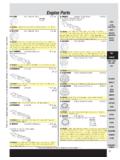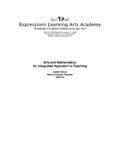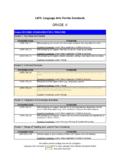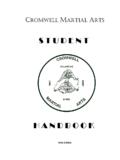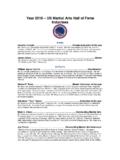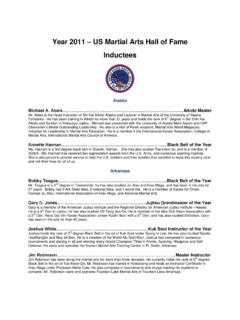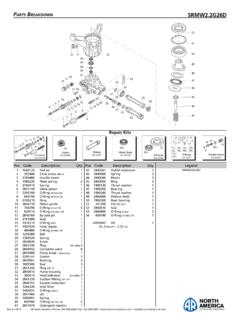Transcription of Arts in the Early Childhood Creative Curriculum
1 Office name/footer [12pt Calibri white] arts in the Early Childhood Creative Curriculum Reframing arts -Related Interest Areas CPS Department of arts Education Page 1 Of the ten named Interest Areas in The Creative Curriculum for Preschool, Dramatic Play, Art, Music and Movement can be especially effective at introducing a wide variety of experiences for students throughout the day while supporting standards for preschool. Early Childhood teachers, even with limited training in the arts , can work to deliver meaningful and high quality arts instruction. The Creative Curriculum for Preschool provides excellent suggestions for embedding arts content into weekly planning, and can even be taken farther. Here are some additional suggestions for each arts area: Dance: Learning about the body s ability to move and using rhythm and space in different ways. Dance Exploring the Topic Activity Ideas Rationale Dance Making Developing skills and techniques Improvising Choreographing Performing In what ways can my body move?
2 Why do different people create different movements? In what ways might we improve our dance? Why might a dance feel different to an audience from the way it feels to the performer? Practice structured warm-ups: - Learn and lead students in Anne Green Gilbert s rhyming BrainDance for children ages 0-5 years. - Handout: Rhyming from Teaching the Three Rs Through Movement Experiences by Anne Green Gilbert Move in different levels: low, middle, high. Move in different directions: forward, back, side, up, down. Move in straight, circular, curved, and zigzag pathways in the air and through space. Execute basic locomotor (traveling) movements. Practice freezing and traveling, starting and stopping. Practice basic motor skills: walk, run, leap, hop, jump, skip, and gallop. Improvise with props: balls, hoops, ribbons, scarves. Explore original movement and dance concepts: - Follow-the-leader - Mirroring - Partnering - Responding to music Explore images that suggest a beginning, middle and end.
3 Compose a short dance phrase a movement sentence with a beginning, middle and end. Perform for peers in dance class. Participate in group decisions about class choreography. Perform for students and family at school assemblies, celebrations, and at Wow experiences. The BrainDance is an effective full body and brain warm-up for people of all ages. It is composed of eight developmental movement patterns human beings are programmed to move through from 0-12 months that wire the central nervous system. By moving through these movements and using them in a fun musical ways, children have a varied movement experience to assist in wholeness and integration of body and brain. Exploring original movement helps students with focus and concentration. Movement can highlight response to music, images, words, ideas, and symbols and help children distinguish a range of movement qualities to express feelings, characteristics, sensations, and environments.
4 Students begin to understand the concepts of cooperation through the examination of body shapes and body actions. Students become keen observers and can manipulate and remember dance experiences. Through performance, students demonstrate the ability to recall, repeat, and refine movement sequences. Student increase expressiveness and coordination. Students begin to develop positive audience behaviors. Dance Literacy Critical and Creative Thinking History and Culture Why do people dance? Why do people from different places dance in many different ways? Contribute to a list of reasons people dance, sharing personal dance experiences. Students talk about favorite dance activities with the class. Take performance to another Students understand performance space and meaning in performance. Students understand that dance is a special way of expressing and communicating.
5 Students develop basic dance Office name/footer [12pt Calibri white] arts in the Early Childhood Creative Curriculum Reframing arts -Related Interest Areas CPS Department of arts Education Page 2 Dance Vocabulary How do our surroundings change our dance? space like to outdoors and discuss how space changes meaning. Respond to action words in texts and symbols with movement. Name different body parts we use while dancing and Demonstrate various shapes with the body. Contribute to a class word wall on dance View different types of dance performances live, on film, or on the web. Respond verbally and in movement to famous dancers and dance works. vocabulary. Students respond in words, movement or pictures. Students understand that there are different approaches to and forms of dance. Dance Making Connections Personal Connections Cross-Curricular Connections Where do you see people dancing?
6 How does dance help us to be strong and healthy? How do animals move? Can we move like animals? Family Partnerships: interview parents/guardians about the dance tradition of their childhoods, and share with the class. Interview classmates to find out whether and in what ways dance is a regular part of their family experience. Learn dances marking holidays, celebrations and traditions of various cultures. Learn or invent dances using: - Music: rhythms - Visual Art: movement, color, spatial design in a painting - Theatre: character-based movement - Language arts : actions, dynamics or pathways drawn from words and images in a book - Math: geometric shapes in the body or in group formations - Science: movement qualities found in natural elements in different seasons; movement qualities of various animals Explore and observe changes in posture and describe how they affect mood.
7 Students actively observe the movements of other students, people, and things. Students begin to learn about various cultures and historical periods. Student connect dance to other disciplines. Students connect dance to health and well-being. Office name/footer [12pt Calibri white] arts in the Early Childhood Creative Curriculum Reframing arts -Related Interest Areas CPS Department of arts Education Page 3 Music: Developing an awareness of different kinds of music and becoming comfortable with different forms of musical expression Music Exploring the Topic Activity Ideas Rationale Music Making Developing Skills and Techniques Singing Playing Instruments Performing What is the difference between music and noise? Why does some music make us feel happy and some music make us feel sad? Learn, sing, and performs songs individually and in a group.
8 Perform in unison and in a round with varying dynamics. Sing songs that demonstrate the ability to sing loud/soft, high/low, and fast/slow. Sing a variety of chants, games, and call-and-response songs. Clap simple rhythmic patterns individually and in a group. Listen to a CD containing soothing environmental sounds ( , ocean, rainforest, birds, wind, etc.) then have small groups of students recreate the sounds while the rest of the class closes their eyes and imagines. Play simple rhythmic patterns on classroom instruments or using found objects to create sounds ( : homemade shakers, buckets, spoons, etc.) Improvise a response to a rhythmic pattern by clapping. A complete music experience includes opportunities for hands-on and interactive learning, self-expression, and reflection. Music Literacy Reading and Notating Music Genre and Style Instruments, Voices, and Ensembles Music Vocabulary Why might music make you feel different emotions?
9 How is your speaking voice different from your singing voice? What is the difference between loud/soft, high/low, fast/slow in music? Identify high and low through visual icons. Though movement, identify high/low, loud/soft, fast/slow in musical selections. Make connections between sounds and symbols. Identify ensemble groupings. Categorize voice types and hoe they sound. Categorize instruments and the sounds they make. Listen to a music selection sung by different artists/groups. Compare/contrast each performance. A complete education in music develops the ability to use and understand the language of music through listening and responding to live and recorded repertoire, notation, recording, and music technology, description, analysis, and evaluation. Music Making Connections Personal Connections Cross-Curricular Connections Where do you see people making music?
10 Where or when do you see people singing or playing instruments? How does music help us to feel? Where else do you hear music? What sounds do we hear outside? Define music as a means of self-expression. Describe the mood of a piece of music. Sing and play music from a variety of world cultures. Use student-constructed puppets to communicate responses to music. Listen to music that tells a story. Students recognize parallels between music and other disciplines. Students gain an understanding of the cultural and historical context of music. Students explore personal connections with music. Office name/footer [12pt Calibri white] arts in the Early Childhood Creative Curriculum Reframing arts -Related Interest Areas CPS Department of arts Education Page 4 Drama: Communicating a message or story through action and dialogue. Drama Exploring the Topic Activity Ideas Rationale Drama Making Developing skills and techniques Imagination, analysis and process skills Choreographing Performing In what ways can we tell stories with our body, voice, and mind?
